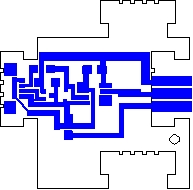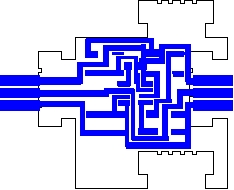Amon Millner
|
|
|||
| Weekly Assignments | |||
|
The "Claytroller" made using my
"Scratch Patch" infrastructure |
|||
| The project presented to the class |
These photos were taken right before I finished wiring up and programming the claytroller for the "How to Make Almost Anything" class presentation. In the picture on the right, the claytroller is surrounded by the versions of Scratch Patches I developed for this project. |
||
   I came up with the idea for Scratch patches after I explored ways to connect multiple circuit boards (that serve different functions). The Scratch Patch schematic on the left is the design for a patch that communicates with computers serial ports through it's left side - voltage/ground/data-line are routed to the right side to listen to all Scratch Patches connected to it. The Scratch Patch schematic in the middle is the design for a simple patch that routes the voltage/ground/data lines straight across the board - stopping through 4 pushbuttons, 1 pull-up resistor, and 1 ATtiny15L microprocessor along the way (far right photo). |
|||
|
The insides of the claytroller uses two-layers of Scratch Patches. The patches used are (from left going clockwise) a "thick" (1/4")/straght-through/button patch, a communicator patch, a button patch, a filler patch, and an extender patch. The filler patch is placed under the 4-button patch. The extender patch takes the voltage/ground/data lines from the communicator patch is sits underneath and routes it to the thick/button patch (that occupies both layers). Patches without surface mount electronic components soldered onto them can serve as connectors - both by connecting on the sides or by stacking (thanks to the voltage/ground/data lines that wrap around under each patch). A photo of 1/4" and 1/8" patches is on the right. |
|||
|
[a photo will be here at some point]
The Claytroller's two button patches are (almost) programmed to be polite when sending their pressed-button status to the communicator patch - that in turn sends the button status to whatever piece of software it's programmed to speak to. The Claytroller was programmed to send button press events to the Scratch programming environment my research group is developing. |
|||
|
|
|||